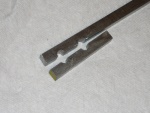| View previous topic :: View next topic |
| Author |
Message |
Sea Wolf
Joined: 01 Nov 2003
Posts: 8650
City/Region: Redding
State or Province: CA
C-Dory Year: 1987
C-Dory Model: 22 Cruiser
Vessel Name: Sea Wolf
Photos: Sea Wolf
|
 Posted: Sun Jan 06, 2008 2:13 am Post subject: Posted: Sun Jan 06, 2008 2:13 am Post subject: |
 |
|
| CAVU wrote: | 
My makeshift wire crimper. I used this setup to make a short jumper cable which needed to be just the right length. I used 3/8 in square bar stock. Clamp together and center drill in a drill press. Use a bit just a little smaller than the crimp. I experimented a little to get just the right size. Clamp tight in a bench vise. Hey I'm cheap. |
Hey Ken!
I'm with you, especially on the cheap part!
Your tool looks like an inexpensive Nicopress swaging tool made to allow swaging of stainless cables on small sailboats:

Good idea!
See Ya' in Seattle!
Joe.  
_________________
Sea Wolf, C-Brat #31
Lake Shasta, California
  
"Most of my money I spent on boats and women. The rest I squandered'. " -Annonymous |
|
| Back to top |
|
 |
mikeporterinmd
Joined: 15 Sep 2006
Posts: 645
State or Province: MD
C-Dory Year: 2002
C-Dory Model: 22 Cruiser
Vessel Name: Shelly IV
Photos: Shelly-IV
|
 Posted: Sun Jan 06, 2008 12:02 pm Post subject: Posted: Sun Jan 06, 2008 12:02 pm Post subject: |
 |
|
Ancor makes a nice little lug press that you hit with a hammer in order
to crimp the lugs. Works from 6 on down to something large...
I went with the Blue Seas fuse box busses. The main buss can handle
up to 120 amps, I think. Each circuit coming off is fused. I have two
in the lazarette, one for house power and one that comes off the starting
battery, prior to the switch. This where I run the bildge pump from.
I have never figured out how to fuse the cables from the batteries to
the switch. I have very short (about 7") from the switches to the above
mentioned fuse blocks.
So, if a battery cable shorts, I have big problems. But, everything else
is protected. Does anyone make a good inline breaker so I could
have protection on the battery cables? What amperate should they
trip at? What current does the starter for a 90hp Honda use?
Mike |
|
| Back to top |
|
 |
Plan C
Joined: 16 Apr 2004
Posts: 246
City/Region: Port Townsend
State or Province: WA
C-Dory Year: 2005
C-Dory Model: 22 Cruiser
Vessel Name: Susie Q
|
 Posted: Sun Jan 06, 2008 1:04 pm Post subject: making cables Posted: Sun Jan 06, 2008 1:04 pm Post subject: making cables |
 |
|
A good crimp is probably adequate, but you can easily solder as well. I use a small Ronstan torch (WalMart) to heat the fitting and wire so the solder gets sucked in. That will fill some spaces.
Dave |
|
| Back to top |
|
 |
CAVU
Joined: 02 Nov 2003
Posts: 665
City/Region: Spokane
State or Province: WA
C-Dory Year: 2002
C-Dory Model: 22 Cruiser
Vessel Name: CAVU
Photos: CAVU
|
 Posted: Sun Jan 06, 2008 2:23 pm Post subject: Posted: Sun Jan 06, 2008 2:23 pm Post subject: |
 |
|
Everything I have read would indicate that all the connections should be crimped and not soldered? I think the reasoning is if the wire heats up it could melt the low temperature solder from the connection and cause arcing. I can't remember where I read this. Anyone know if there is a "rule" on this?
_________________
Ken Trease
22 CD Cruiser, CAVU
Twin 40HP Hondas |
|
| Back to top |
|
 |
Larry H
Joined: 02 Nov 2003
Posts: 2041
City/Region: Tulalip,
State or Province: WA
C-Dory Year: 1991
C-Dory Model: 22 Cruiser
Photos: Nancy H
|
 Posted: Sun Jan 06, 2008 2:32 pm Post subject: Posted: Sun Jan 06, 2008 2:32 pm Post subject: |
 |
|
Mike,
A fuse or breaker is NOT required on the battery cable to the starter motor. If you are concerned about a short, you could run that wire inside a sheath. As far as I know, no motor manufacturer uses a fuse in the battery cable from the starter motor to the battery. The current load is very large when the starter operates.
To see what that current can be, check your motor's owners manual for the cranking amps required from the battery. Marine batteries are rated for 'MCA' (marine cranking amps), that is amps available at 32 degrees F. Auto batteries are rated for 'CCA' (cold cranking amps), which is amps available at 0 degrees F.
Any fuse in the starter circuit would have to be large and expensive and if it failed, you might not be able to start your motor in an emergency.
_________________
Larry H

A C-Brat since Nov 1, 2003
Ranger Tug 27 ex 'Jacari Maru' 2017 - 2022
Puget Trawler 37 ex 'Jacari Maru' 2006-2017
1991 22' Cruiser, 'Nancy H'--1991-2006 |
|
| Back to top |
|
 |
mikeporterinmd
Joined: 15 Sep 2006
Posts: 645
State or Province: MD
C-Dory Year: 2002
C-Dory Model: 22 Cruiser
Vessel Name: Shelly IV
Photos: Shelly-IV
|
 Posted: Sun Jan 06, 2008 6:30 pm Post subject: Posted: Sun Jan 06, 2008 6:30 pm Post subject: |
 |
|
| CAVU wrote: | | Everything I have read would indicate that all the connections should be crimped and not soldered? I think the reasoning is if the wire heats up it could melt the low temperature solder from the connection and cause arcing. I can't remember where I read this. Anyone know if there is a "rule" on this? |
You shouldn't solder because a hard spot is created between the solder
and the flexible portion of the wire. If the wires flex at all, then the
wire will break at that point. So, soldering on items prone to vibration or
flexing wires is not a good idea.
Having said that, I just got done soldering the tiny wires that from a GPS
into an Icom 422. The wires on the Icom are coaxial and very small.
Soldering these is really the only option. The resulting wad of tape I
needed to ensure the wires don't flex and break is substantial. Honestly,
if someone gets hurt because the wires break on someone's 422 and
Icom gets sued, I hope the plaintiffs win. Using such tiny wires on a
life saving device is stupid. I should replace that radio.
Mike |
|
| Back to top |
|
 |
Wandering Sagebrush
Joined: 21 Jan 2005
Posts: 2784
City/Region: Northeast Oregon
State or Province: OR
C-Dory Year: 2005
C-Dory Model: 22 Cruiser
Vessel Name: Constant Craving
Photos: Constant Craving
|
 Posted: Sun Jan 06, 2008 6:58 pm Post subject: Solder vs Crimp Posted: Sun Jan 06, 2008 6:58 pm Post subject: Solder vs Crimp |
 |
|
Another reason to crimp is the chance of getting a cold solder joint between the wire and terminal connection. A cold joint would give a high resistance and hence a voltage drop at the point where it occurs.
Steve |
|
| Back to top |
|
 |
thataway
Joined: 02 Nov 2003
Posts: 21529
City/Region: Pensacola
State or Province: FL
C-Dory Year: 2007
C-Dory Model: 25 Cruiser
Vessel Name: thataway
Photos: Thataway
|
 Posted: Sun Jan 06, 2008 8:54 pm Post subject: Posted: Sun Jan 06, 2008 8:54 pm Post subject: |
 |
|
The principle of not using solder on boats is generally a good one, but consider that many connections in electronics are soldered. I crimp all of the wires, from #6 up to #22, and occasionally solder smaller wires--and of course antennas. A skilled person should not get a cold solder joint. The solder in the heavy cables, is about preventing corrosion as well as contact. The crimp is made first (The Ancor crimper I mentioned is the one which can be hit with a hammer, or used with a vise or vise grip pliers.) The heating to melt solder should not happen at terminals--remember that the battery terminals are lead! The Nicro Press swage fittings may or may not be the correct size--but it can be useful at times. I have both size in the shop.
_________________
Bob Austin
Thataway
Thataway (Ex Seaweed) 2007 25 C Dory May 2018 to Oct. 2021
Thisaway 2006 22' CDory November 2011 to May 2018
Caracal 18 140 Suzuki 2007 to present
Thataway TomCat 255 150 Suzukis June 2006 thru August 2011
C Pelican; 1992, 22 Cruiser, 2002 thru 2006
Frequent Sea; 2003 C D 25, 2007 thru 2009
KA6PKB
Home port: Pensacola FL |
|
| Back to top |
|
 |
AstoriaDave
Joined: 31 Oct 2005
Posts: 994
City/Region: Astoria
State or Province: OR
|
 Posted: Sun Jan 06, 2008 10:37 pm Post subject: Posted: Sun Jan 06, 2008 10:37 pm Post subject: |
 |
|
mikeporterinmd wrote: Having said that, I just got done soldering the tiny wires that from a GPS into an Icom 422. The wires on the Icom are coaxial and very small. Soldering these is really the only option. The resulting wad of tape I needed to ensure the wires don't flex and break is substantial.
Same radio, same connections, used same solution. I agree those smaller wires do not crimp well. Heat shrink tubing is a good alternative to tape. Used properly, it will protect the soldered part from flexure and practically eliminate any strain on the "hard spot".
Also agree that a cold solder joint is unlikely in smaller diameter wire. I do not solder anything larger than 16 ga wite, even though I earned a living in the days of NASA-certified (and inspected) wiring on modules for rocket gear. I know that if I do not solder regularly, I lose my touch.
_________________
Dave Kruger
Astoria, OR |
|
| Back to top |
|
 |
tsturm
Joined: 01 Nov 2003
Posts: 1173
City/Region: Soldotna
State or Province: AK
C-Dory Year: 2003
C-Dory Model: 25 Cruiser
Vessel Name: JMR TOO
Photos: JMR-TOO
|
 Posted: Sun Jan 06, 2008 11:42 pm Post subject: Posted: Sun Jan 06, 2008 11:42 pm Post subject: |
 |
|
| AstoriaDave wrote: | mikeporterinmd wrote: Having said that, I just got done soldering the tiny wires that from a GPS into an Icom 422. The wires on the Icom are coaxial and very small. Soldering these is really the only option. The resulting wad of tape I needed to ensure the wires don't flex and break is substantial.
Same radio, same connections, used same solution. I agree those smaller wires do not crimp well. Heat shrink tubing is a good alternative to tape. Used properly, it will protect the soldered part from flexure and practically eliminate any strain on the "hard spot".
Also agree that a cold solder joint is unlikely in smaller diameter wire. I do not solder anything larger than 16 ga wite, even though I earned a living in the days of NASA-certified (and inspected) wiring on modules for rocket gear. I know that if I do not solder regularly, I lose my touch. |
I crimp, Solder & shrink tube Every thing always. In 30 yrs I have Never had a problem. If you solder the connection only you will not have a brittle wire problem. I have seen lots more crappy crimped connections causing voltage drops than a solder joint! If you have vibration cuasing problems with your wiring on your boat you have way bigger issues. Have a good one!!   |
|
| Back to top |
|
 |
|

 Search
Search Private Messages
Private Messages Profile
Profile Log in
Log in Register
Register Help
Help










